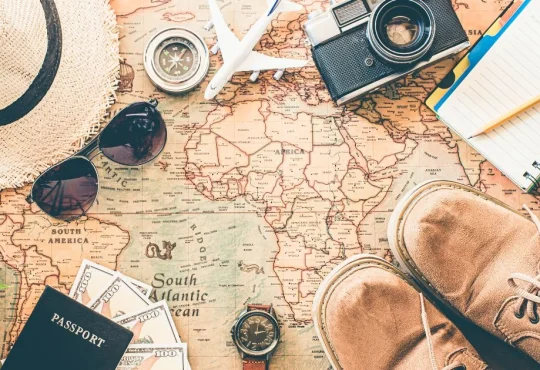Traveling is an exhilarating and eye-opening journey that enables you to discover new places and embrace different cultures. However, as thrilling as travel can be, it also requires careful planning, especially regarding budgeting. Transportation, accommodation, food, and activities can quickly add up without a clear financial plan. Setting a realistic budget helps ensure your travel dreams don’t become financial stress. This post will guide you through determining how much to allocate for your next exciting travel goals in 2025.
Understanding Your Travel Goals
Before you can start budgeting, you need to understand what type of traveler you are. Your travel style will determine much of your budget allocation. Are you a budget-conscious traveler, a luxury-seeking explorer, or somewhere in between? Let’s dive deeper into each category:
- Budget Traveler: Budget travelers prefer affordable accommodations, local cuisine, and free or low-cost activities. Their goal is to experience the essence of a destination without spending too much. Think hostels, street food, and walking tours.
- Luxury Traveler: Luxury travelers, on the other hand, enjoy the finer things in life. High-end hotels, fine dining, and exclusive tours are the norm. This travel style focuses on comfort, pampering, and indulgence, requiring a larger budget.
- Mid-Range Traveler: For those who want a balance between comfort and affordability, the mid-range traveler seeks moderate spending on accommodations, meals, and activities. This approach offers a bit of luxury without breaking the bank.
Once you’ve identified your travel style, it’s time to set realistic goals for your trip. Consider your destination, the length of your stay, and the activities you want to experience. Do you dream of a two-week European vacation or a weekend getaway in a neighboring city? The more extended and luxurious the trip, the more you must allocate to your budget.
Estimating Your Travel Costs
Once you’ve defined your travel style and goals, the next step is estimating how much your trip will cost. Here are the main categories to consider when building your travel budget:
1. Transportation
Transportation is often the most significant expense in your travel budget. Depending on your destination, there are different ways to save money.
- Flights: Compare options on websites like Google Flights, Skyscanner, or Kayak for the best deals. Keep an eye out for sales and book in advance to save money. Consider booking your flight mid-week or during off-peak hours to snag better deals.
- Public Transportation: Most destinations offer affordable and efficient public transportation systems: research local buses, trains, and subways to save on taxis or rideshares.
- Rental Cars: If you’re traveling to a destination where public transportation isn’t ideal, you may need to rent a car. Remember to factor in the cost of fuel and insurance. Some destinations offer great deals on rental cars, but always compare prices.
2. Accommodation
Accommodation is another significant chunk of your travel budget, but there are plenty of options depending on your travel style.
- Hotels and Resorts: Hotels range from budget-friendly options to luxurious five-star resorts.—research various options to find one that suits your style and budget. Use booking sites like Booking.com, Agoda, or Airbnb to compare prices and read reviews.
- Vacation Rentals: Renting an apartment or house might be a great option if you prefer a homier experience or are staying for an extended period. Vacation rentals can offer good value, especially for families or groups.
- Camping: If you’re an outdoor enthusiast, camping might be a cost-effective way to stay. Many national parks and outdoor destinations offer affordable campsites.
3. Food
Food is one of the most enjoyable parts of traveling, but it can quickly become a significant expense.
- Dining Out: Research the average cost of meals in your destination. In some countries, dining out is inexpensive; in others, it can add up quickly. Street food is often cheaper and a great way to experience local flavors.
- Cooking: If your accommodation has a kitchen, consider cooking your meals. You can save money and enjoy fresh, local ingredients. Some vacation rentals or even in-house chefs offer markets nearby to help with meal prep.
4. Activities and Attractions
The experiences you have on your trip will significantly impact your budget.
- Free Activities: Many destinations offer free activities like hiking, visiting parks, or exploring museums. Check for free walking tours, local festivals, and public beaches.
- Paid Activities: Depending on your destination, you can budget for paid activities like guided tours, tickets to museums, concerts, or theme parks—factor in the cost of these activities when building your budget.
5. Miscellaneous Expenses
Remember the small, unexpected costs that may arise during your trip.
- Souvenirs: Allocate a small budget for souvenirs or gifts. It would help if you took home a little piece of your adventure.
- Travel Insurance: Travel insurance is a crucial component of any trip, safeguarding you from unexpected situations such as flight cancellations, health emergencies, or lost luggage. It’s worth investing in to protect your travel experience.
Creating a Realistic Travel Budget
Once you’ve assessed your expected travel costs, it’s time to create a realistic budget. Here are a few strategies to help guide your planning:
- Percentage-Based Budgeting: One effective method for travel budgeting is percentage-based saving. You can allocate a specific percentage of your monthly income, like 10-15%, to build your travel fund. This approach encourages consistency and discipline in saving for your trip. You steadily progress toward your goal by automatically diverting this portion of your income each month. The essential advantage of this method is that it works for all budgets, regardless of your income level.
- Destination-Based Budgeting: If you already have a particular destination, destination-based budgeting is a great strategy. Start by researching the average costs for flights, accommodations, food, and activities in that location. Some countries, like Southeast Asia, are more budget-friendly than expensive destinations in Europe or North America. By understanding the cost of living in your chosen destination, you can plan a more accurate and realistic budget. This method also helps you adjust your expectations or modify your travel plans.
- Goal-Based Budgeting: Goal-based budgeting is another powerful way to allocate funds for travel. If you know your dream vacation will cost around $3,000, break that down into monthly savings goals—factor in fixed expenses like flights and hotel stays and variable costs like meals and excursions. Knowing how much you need to save each month allows you to plan and track your progress more effectively. This method helps you stay motivated and focused on your target amount, ensuring you reach your goal in time.
- Use Budgeting Tools: Budgeting tools can make tracking and managing your travel budget much more manageable. Apps like Mint, YNAB (You Need a Budget), and PocketGuard help you monitor your spending and set saving goals. These tools automatically categorize your expenses, making it easy to see where your money goes. Spreadsheets can also be a straightforward and efficient method for tracking your savings, especially if you prefer a more hands-on, manual approach. Leveraging technology helps you stay on track and spend time wisely while working toward your travel goals.
Tips for Saving Money on Travel
Saving money for travel doesn’t have to be a challenge. Here are some tips to help you keep your costs low:
- Off-Peak Travel: One of the best ways to save on travel is to go during off-peak seasons. Airfares, accommodations, and activities are generally more affordable when you avoid peak tourist times. It applies not only to flights but also to hotels, tours, and even local attractions. Traveling during these less busy periods allows you to experience the destination without the high costs associated with peak travel times. Additionally, you’ll enjoy a more relaxed atmosphere, with fewer crowds and less competition for popular activities.
- Flexible Travel Dates: Flexibility in your travel dates can help you take advantage of the best deals available. Airline prices and hotel rates fluctuate depending on the time of year, the day of the week, and even the time of day you book. You may find significant savings by adjusting your travel dates by just a few days. For instance, flights on Tuesdays and Wednesdays are often cheaper than those on weekends. Minor adjustments to your schedule can make a big difference in lowering your overall travel expenses.
- Use Travel Rewards Programs: Many airlines and hotel chains offer rewards programs that let you accumulate points and miles, bringing you closer to future travel adventures. These programs are free to join and can be incredibly beneficial, especially for frequent travelers. You can earn more reward points using your credit card for everyday purchases. These points can be redeemed for flights, hotel stays, and even car rentals, helping you save on travel expenses. Signing up for these programs can be a simple yet effective way to save money in the long run.
- Pack Light: Packing light can save you both money and time during your travels. You can avoid baggage fees by avoiding checked luggage, which can add up quickly. Opt for carry-on luggage to avoid extra costs and skip the hassle of waiting at baggage claim. Additionally, you’ll be able to move around more easily, whether navigating airports, hopping on trains, or taking public transportation. Packing light can make your entire travel experience more efficient and less costly.
- Cook Your Meals: One great way to reduce travel expenses is to cook meals instead of always eating out. Shopping at local markets for fresh ingredients is often cheaper than dining at restaurants. Many accommodations offer kitchens, allowing you to prepare your meals at a fraction of the cost. Cooking local dishes also enables you to immerse yourself in the culture and flavors of your destination. It’s a fun and budget-friendly way to enjoy the authentic tastes of the place you’re visiting.
- Travel Off the Beaten Path: Consider exploring lesser-known destinations less popular with tourists. These off-the-beaten-path locations often offer unique experiences you won’t find in the crowded tourist hotspots. Not only can you avoid the high costs of tourist-heavy destinations, but you’ll also enjoy a more authentic travel experience. At lower prices, many places offer hidden gems like local markets, quieter beaches, and unexplored nature spots. Visiting these under-the-radar destinations can also help you avoid the crowds, giving you a more peaceful and relaxed trip.
Achieve Travel Goals with Affordable Adventures
Traveling can be within reach. Planning, budgeting carefully, and strategically planning can make your travel dreams a reality without breaking the bank. The key to successful travel budgeting is setting achievable goals, researching expenses, and maintaining discipline with your savings plan. So, how much should you allocate for your next adventure? It depends on your travel goals, but with the proper planning, you can save for a journey worth every penny. Start planning today, and let the world be your next destination!





